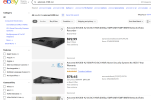I need to connect two cheap ONVIF cameras in a friends house to the
Blue Iris in my house over internet.
How close is the friends house?
Does the friend require access to review the video feed either live or as a time line?
1) If within 100 meters then run a CAT-5 for your camera data.
2) Or if within line of sight then an RF link like the airMAX LiteBeam 5AC.
3) Or if close and on the same side of the 220 VAC power transformer then one of the Ethernet over power line devices might work for the data link.
4) If none of the above are practical then consider installing BI, on another computer, at the friends house for all video capture needs. Or as previously mentioned above, an inexpensive NVR.
The idea, in this scenario, is to use your existing BI system for video storage and camera management. Thus not requiring large uploads to the internet which may be slow and monthly limited by the ISP.
If your friend need remote access to the video from your house then install TailScale on your BI computer and on any other remote device such as the friend's laptop, desktop or phone.
Note: Some BI systems use dual NICs with one connected to your LAN and the other connected to a POE switch and then to BI. With this scenario, both NICs can be prevented form internet connectivity thus keeping the entire system off the net.
The downside if internet isolated, then BI updates become more of a issue plus TailScale will not function without an internet connection.
Note that TailScale, in exit point mode, works well for BI systems that do not have internet access. This can be accomplished by either adding TailScale to your router or adding a GL-MT3000 Travel Router (TailScale built in) to access UI3 on your LAN.

